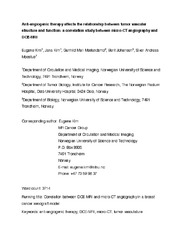Anti-angiogenic therapy affects the relationship between tumor vascular structure and function: a correlation study between micro-CT angiography and DCE-MRI
Permanent lenke
https://hdl.handle.net/10037/10107Dato
2016-11-25Type
Journal articleTidsskriftartikkel
Peer reviewed
Sammendrag
Purpose: To compare the effects of two anti-angiogenic drugs, bevacizumab and a
cytosolic phospholipase A2-α inhibitor (AVX235), on the relationship between vascular
structure and dynamic contrast enhanced (DCE)-MRI measurements in a patient-derived
breast cancer xenograft model.
Methods: Mice bearing MAS98.12 tumors were randomized into three groups:
bevacizumab-treated (n=9), AVX235-treated (n=9), and control (n=8). DCE-MRI was
performed pre-and post-treatment. The median initial area under the concentration-time
curve (IAUC60) and volume transfer constant (Ktrans) were computed for each tumor. The
tumors were excised for ex vivo micro-CT angiography, from which the vascular surface
area (VSA) and fractional blood volume (FBV) were computed. Spearman correlation
coefficients (ρ) were computed to evaluate the associations between the DCE-MRI and
micro-CT parameters.
Results: With the groups pooled, IAUC60 and Ktrans correlated significantly with VSA
(ρ=0.475 and 0.527, P=0.019 and 0.008). There were no significant correlations within
the control group. There were various significant correlations within the treatment groups
but the correlations in the bevacizumab group were of opposite sign, e.g., Ktrans vs. FBV:
AVX235 ρ=0.800 (P=0.014), bevacizumab ρ=-0.786 (P=0.023).
Conclusion: DCE-MRI measurements can highly depend on vascular structure. The
relationship between vascular structure and function changed markedly after antiangiogenic
treatment.


 English
English norsk
norsk